Delta Airlines Business Model Canvas 2024
While starting out as a crop dusting company in the 1920s, Delta Airlines has evolved into one of the world’s largest and most awarded carriers, serving well over 200 million customers annually through its extensive route network connecting all corners of the globe. In this Delta Airlines business model canvas, we will learn its customer segments, value proposition, revenue streams, channels, customer relationships, key activities, key resources, key partners, and cost structure.
Interesting fact!
During the COVID-19 pandemic, Delta transformed some of its idle wide-body aircraft into “mini hospitals” to help military personnel safely transport medical patients.
Delta Airlines Competitors
American Airlines | United Airlines | Southwest Airlines | JetBlue | Alaska Airlines | Air Canada | Spirit Airlines | Frontier Airlines | Hawaiian Airlines | Allegiant Air
Customer Segments – Delta Airlines Business Model Canvas
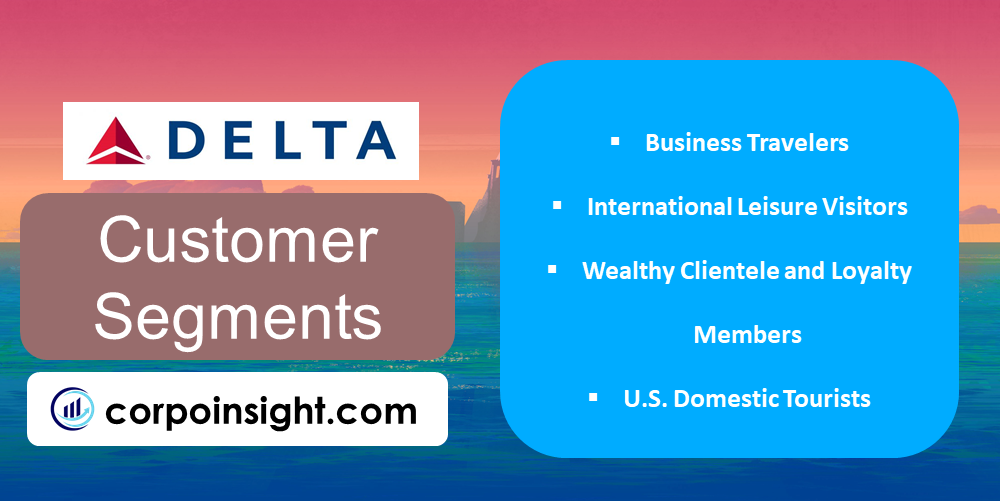
Business Travelers: Delta has a strong share of high-value corporate contracts and over 50 Delta Sky Club airport lounges to appeal to business travellers seeking productivity and convenience. In 2021, corporate travel revenue accounted for 26% of the total.
International Leisure Visitors: Through partnerships like Virgin Atlantic, Delta served over 200 million international origin and destination passengers annually pre-pandemic. Marketing focuses on wider seats, meals and award-winning service.
Wealthy Clientele and Loyalty Members: Delta’s premium products, like Delta One business class, tap into higher disposable incomes. The 360-page Sky Magazine and dedicated Sky Club lounges create an elite experience for Diamond/Platinum Medallion loyalty members, representing 10% of customers.
US Domestic Tourists: Delta leverages its fortified Atlanta hub and the breadth of its domestic route network covering over 50% of the population within the U.S. to attract a high volume of American vacation travellers and visiting friends and relatives.
Value Proposition – Delta Airlines Business Model Canvas

Breadth of Global Network: Delta serves over 300 destinations in over 50 countries, offering convenient access for both business and leisure travellers. In 2021, international passenger traffic rebounded to 63% of 2019 levels.
Industry-Leading Reliability: Delta has consistently been ranked as one of the world’s most on-time airlines, with only 1.36% of 2021 flights delayed, according to DOT reporting. This minimizes potential missed connections for customers.
Premium Experience: Delta invests heavily in premium offerings like Delta One suites and upgrades the tech experience with AI-powered automation. This satisfies discerning higher-paying travellers, including lucrative corporate accounts.
Loyalty Rewards: Delta’s SkyMiles program has over 100 million members who can unlock an array of elite travel-related upgrades and perks, including airline/hotel transfers and exclusive events access, driving repeat business.
Revenue Streams – Delta Airlines Business Model Canvas
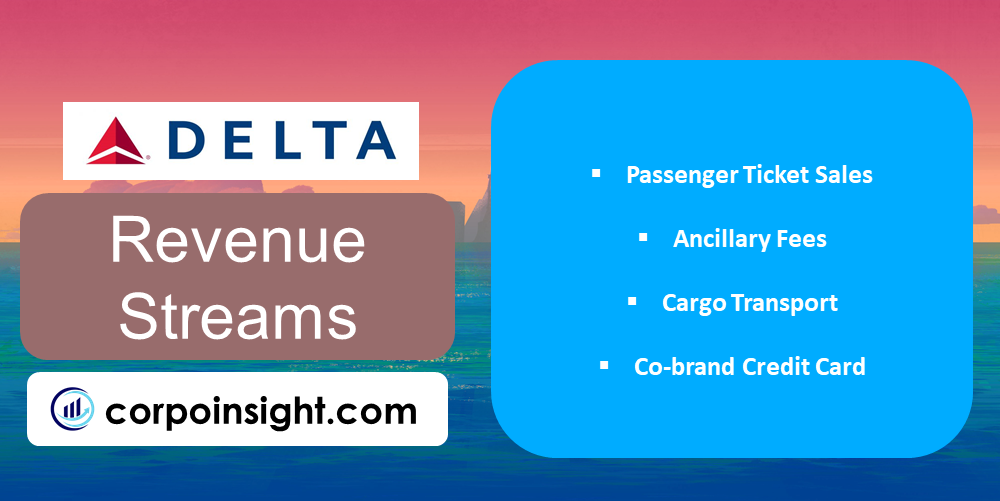
Passenger Ticket Sales: The majority of Delta’s revenues come from the economy, premium economy, and business/first class ticket sales. In 2021, passenger revenues were $19.97 billion, recovering to 73% of 2019 levels, indicating a post-pandemic travel rebound.
Ancillary Fees: Delta generated $8.7 billion in 2021 passenger revenues from additional ancillary options purchased like checked baggage, seat selections, in-flight WiFi, and partner loyalty credits, driving higher customer spending.
Cargo Transport: Delta’s cargo division leverages lower-deck plane capacity to ship goods globally. Cargo revenues grew 52% in 2021 over prior year levels to $918 million through high freight rates and volume demand.
Co-brand Credit Card: Delta has an exclusive U.S. partnership with American Express. Their co-brand portfolio had 11 million card members in 2021, earning Delta over $4 billion through signup bonuses and ongoing cardholder expenditures.
Channels – Delta Airlines Business Model Canvas

Direct Digital Sales: Delta.com and the Fly Delta app accounted for over 60% of total ticket sales. Enabled by $3 billion in tech investments, Delta’s digital platforms provide customizable self-service options for flight bookings, day-of travel changes, and ancillary purchases.
Strategic Partnerships: Delta leverages joint venture partnerships with Virgin Atlantic and Air France-KLM to expand flight options and global connectivity for customers. These deep alliances also afford reciprocal frequent flyer benefits and airport lounge access.
Brick-and-Mortar: Although declining in favour of digital, Delta still invested $50 million in airport lobbies and checkout spots in 2021 to modernize customer service for traditionalists seeking human interaction during travel.
Travel Agencies: Delta has over 1,800 travel agency partners globally that extend its network reach into niche corporate and leisure clientele. Agencies account for approximately 15-20% of overall Delta passenger revenues through overrides and incentives.
Customer Relationships – Delta Airlines Business Model Canvas
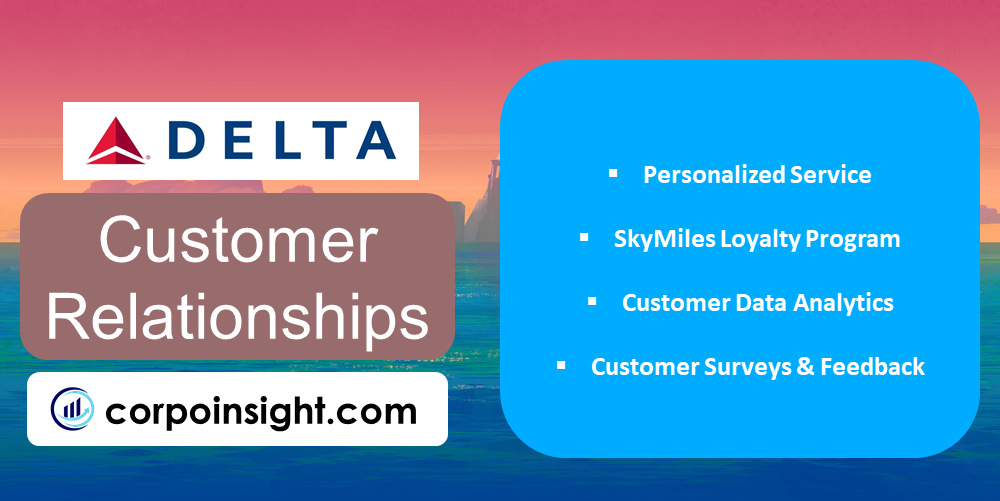
Personalized Service: Delta invests significantly in employee culture and hospitality training to drive meaningful engagements during travel. Recent surveys found that 86% of customers were satisfied with inflight service and airport staff helpfulness.
SkyMiles Loyalty Program: Over 100 million enrolled SkyMiles members earn miles, upgrades and VIP perks incentivizing repeat travel. Targeted tier benefits and surprise giveaways further strengthen brand commitment levels.
Customer Data Analytics: Delta leverages AI-enabled customer analysis across all channels to better understand travellers and deliver real-time support. This facilitated handling over 100 million customer contacts annually pre-pandemic.
Customer Surveys & Feedback: Delta actively tracks satisfaction survey ratings, Net Promoter Scores, social media mentions and feedback calls to quickly address concerns and reinforce positive travel moments when it matters most.
Key Activities – Delta Airlines Business Model Canvas

Efficient Flight Operations: Delta strives for best-in-class operational integrity, and it was the world’s most on-time airline in 2023, with only 1.36% of flights delayed. High completion rates, evolving flight schedules and route optimizations maximize fleet productivity.
Investments in State-of-the-Art Planes: Delta spends over $2 billion annually to update aircraft interiors and install premium amenities. Recent purchases include the fuel-efficient, passenger-preferred Airbus A321neo and A330-900neo with new cabin features.
Ongoing Employee Training: Delta heavily emphasizes industry-leading employee training programs, including its 7-week Flight Attendant Education program and $1 billion committed towards career development and salary boosts amid a talent shortage.
Technology and Digital Innovations: Delta develops award-winning in-house proprietary tech innovations like its Fly Delta app, serving over 20 million users. Biometric boarding, predictive maintenance analytics and AI-enabled customer support drive the next-gen travel experience.
Key Resources – Delta Airlines Business Model Canvas
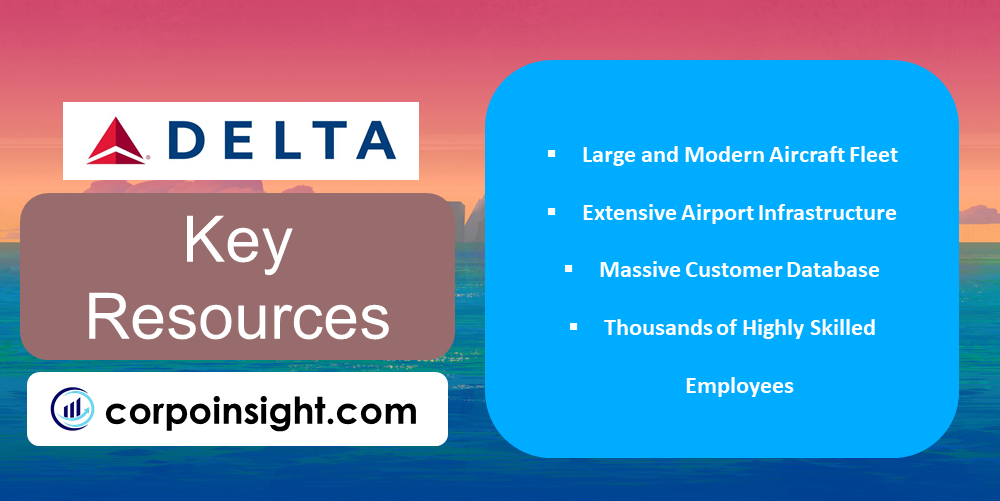
Large and Modern Aircraft Fleet: Delta operates a portfolio of over 978 latest-technology Airbus and Boeing planes optimized for fuel efficiency. The fleet size enables the service of over 300 global destinations, with refurbishments ensuring an industry-leading onboard travel experience.
Extensive Airport Infrastructure: Delta leverages major hub infrastructure in Atlanta, New York, Los Angeles and Detroit, including hundreds of gates/slots and Sky Club lounges. Atlantas’s $8 billion “Mega Hub” expansion will cement Delta’s domestic and international route dominance.
Massive Customer Database: Delta’s 360-degree view of over 100 million loyalty programs and credit cardholders provides invaluable traveller insights to enhance service personalization and drive targeted sales opportunities with its most valuable customer segments.
Thousands of Highly Skilled Employees: Delta employs nearly 90,000 people globally, including over 14,000 pilots and 23,000 flight attendants. Its best-in-class training empowers employees to safely and reliably deliver amazing customer experiences amidst complex airport logistics.
Key Partners – Delta Airlines Business Model Canvas
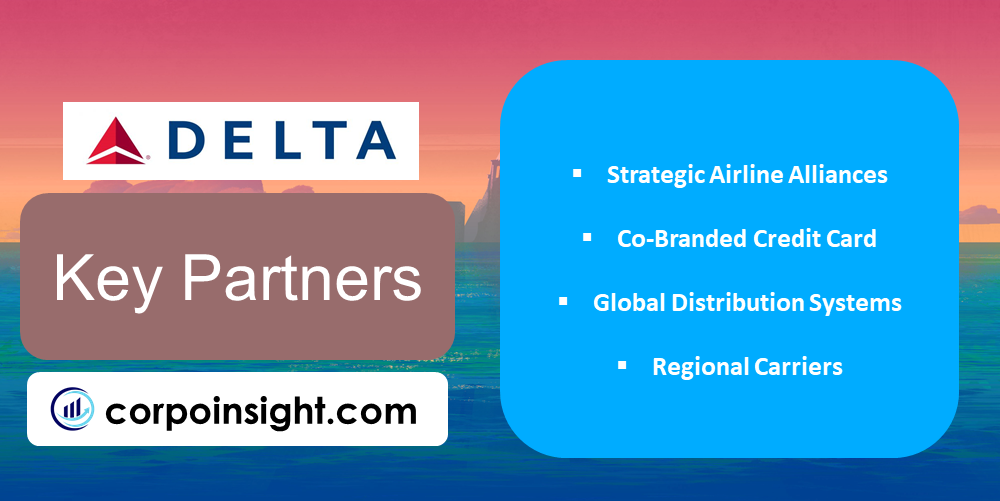
Strategic Airline Alliances: Delta has joint venture partnerships with Virgin Atlantic, Air France-KLM and Aeromexico, enabling seamless connections to over 200 destinations globally. These extend Delta’s network reach, loyalty benefits and airport lounge access.
Co-Branded Credit Card: Delta’s partnership with American Express has over 11 million members, contributing $4 billion annually through card signups and purchases. The cards offer perks like free checked bags, priority boarding and bonus miles driving loyalty.
Global Distribution Systems: Partnerships with Amadeus, Sabre, and Travelport expand Delta’s distribution to thousands of third-party travel agencies and online travel sites, reaching niche corporate and leisure travel segments outside direct channels.
Regional Carriers: Delta has exclusive partnerships with regional airlines like Compass and SkyWest to offer connecting small market flights on its behalf. This expands access options for Delta flyers through aligned schedules and integrated booking systems.
Cost Structure – Delta Airlines Business Model Canvas
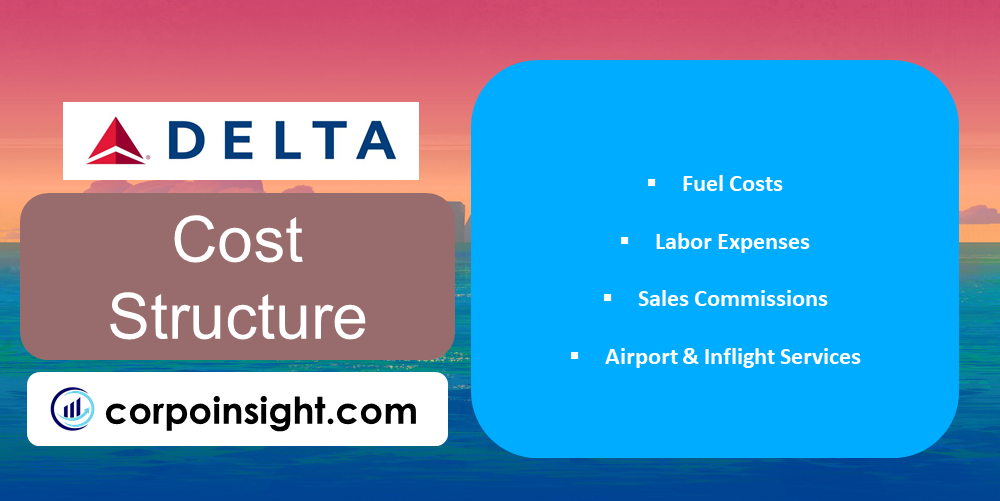
Fuel Costs: Jet fuel represented over 20% of Delta’s 2021 operating costs due to rising oil prices. The airline managed $8 billion in fuel expenses through integrated hedging strategies and investments in over 200 new fuel-efficient aircraft like the A321neo.
Labour Expenses: Salaries, wages, and benefits were Delta’s largest individual expense line at $11.3 billion in 2021, supporting its nearly 90,000 global workforce. New pilot contracts and staffing shortages contributed to a 7% increase over 2020.
Sales Commissions: Incentive payouts to third-party sales channels like online travel agents and booking services accounted for over $2 billion in 2021 customer acquisition costs, representing Delta’s third highest cost area.
Airport & Inflight Services: From passenger meals, aircraft maintenance, and airport fees to loyalty program administration, these facility and operating expenses tallied over $11 billion, supporting essential customer and fleet servicing activities.
Summary of Delta Airlines Business Model Canvas
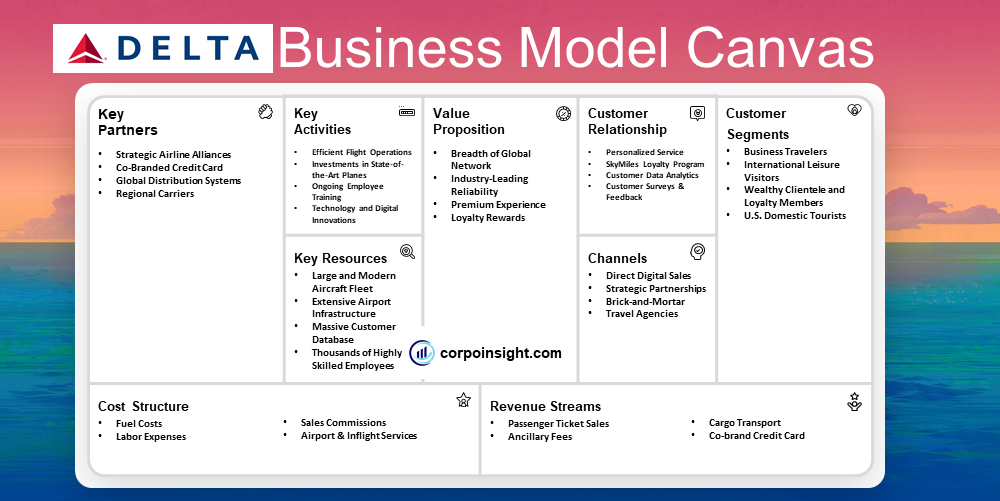
Conclusion on Delta Airlines Business Model Canvas
Delta Airlines has built an extremely well-rounded business model canvas fueled by its massive global scale, operational excellence, and customer service focus. By balancing the needs of premium high-value flyers and economy passengers, investing in proprietary physical and digital assets, and executing through an empowered workforce and strategic partnerships, Delta has positioned itself as a resilient industry leader, offering a best-in-class end-to-end travel experience.

This is Ahsanul Haque, someone very passionate about digital marketing, SEO, and Data Analytics and founder of the Analytics Empire and currently pursuing my major in marketing at Bangladesh University of Professionals.






